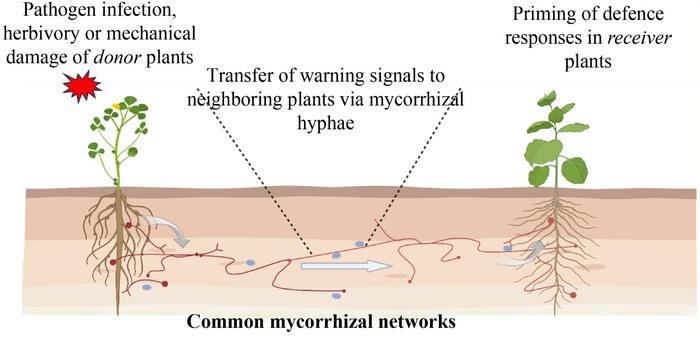In the intricate webs beneath our feet, a remarkable form of communication and collaboration unfolds, reshaping our understanding of plant interactions and resilience. Mycorrhizal fungi, long recognized for their symbiotic role in facilitating nutrient exchange between plants, are now emerging as pivotal conduits for underground signaling—transmitting crucial defense alerts among connected plants when subjected to various stresses. A groundbreaking review led by Professor Erik Limpens of Wageningen University in the Netherlands unveils new insights into these common mycorrhizal networks (CMNs), highlighting their potential to promote communal plant defense strategies and ecological stability.
For decades, mycorrhizal fungi have been appreciated primarily for their ability to extend the root surface area of plants, enhancing absorption of water, nitrogen, phosphorus, and other vital nutrients. However, the scope of their influence extends far beyond nutrient transport. These fungi form extensive hyphal networks that interlink individual plants, creating subterranean channels not merely for nutrient flow but also for the transmission of molecular signals that alert neighboring plants of impending threats. This discovery challenges traditional views on plant communication and offers a compelling perspective on ecosystem-level resistance to biotic and abiotic stressors.
Not limited to tomatoes, analogous phenomena have been observed in a diverse array of plant species, including citrus and alfalfa. In the case of leguminous plants, aphid infestation initiates a fascinating chain reaction: attacked plants release specific volatile compounds that propagate through the CMNs to neighbors, prompting them to emit their own signals that summon the natural enemies of aphids. Remarkably, this communication unfolds rapidly, with measurable responses detected in as little as six hours. Such rapid, preemptive defensive mobilization suggests that CMNs function as sophisticated information highways, enabling plants within a community to collectively sense and respond to threats with coordinated resilience.
The functionality of CMNs extends even into mechanical damage scenarios. When tomatoes experience physical injury, the connected plants linked through the hyphal networks exhibit heightened activity of stress-resistant enzymes. This enzymatic surge indicates an induced state of readiness that bolsters plant defenses across the network, effectively manifesting what can be described as a group-level immune system. The collective defense response not only enhances individual survival but also fortifies the broader plant community against cascading damage.
Importantly, plant roots themselves are active agents in this underground dialogue. They regulate the chemical composition and concentration of secretions dispatched to the mycorrhizal fungi, which, in turn, may passively diffuse or be actively transported across the CMN. Such bidirectional interaction promotes a finely tuned exchange of information, implying that signal transmission is a complex interplay between plant and fungal partners rather than a one-way process. This dynamic reciprocity exemplifies the depth of co-evolution within plant-fungus symbioses.
From an ecological standpoint, the significance of CMN-mediated signaling transcends individual plant survival. When plants detect warning signals transmitted through the fungal networks, they can preemptively activate defensive pathways, diminishing the overall vulnerability of the plant community to outbreaks of pathogens and herbivores. Meanwhile, fungi benefit from this arrangement by nurturing healthier host plants, ensuring a continual supply of photosynthetically derived carbon compounds essential for fungal metabolism and persistence. This mutualistic feedback loop embodies a resilient and stable ecosystem component where both organisms thrive through shared defense and sustenance.
The implications for agriculture and ecosystem management are profound. Understanding how CMNs mediate defense signaling opens new avenues for enhancing crop resistance naturally, potentially reducing reliance on chemical pesticides and fostering sustainable farming practices. By leveraging these subterranean networks, agronomists could promote cooperative plant resilience, buffering crops against increasingly prevalent stresses induced by climate change, pest invasions, and soil degradation.
Currently, the precise molecular identities of the signaling compounds traversing CMNs remain elusive. Future research directions emphasize a need to isolate and characterize these molecules, elucidate the detailed biochemical and biophysical transmission mechanisms, and map how such signals dynamically fluctuate under varying environmental conditions and stresses. Achieving these goals will require integrative approaches combining molecular biology, advanced imaging, electrophysiology, and ecological modeling.
The study published in Frontiers of Agricultural Science and Engineering marks an important turning point in plant sciences by spotlighting the critical role of mycorrhizal networks beyond nutrient exchange. Professor Erik Limpens and colleagues have fundamentally expanded our comprehension of subterranean plant-fungi networks as active, communicative systems that orchestrate complex defenses and maintain ecosystem equilibrium. This paradigm shift holds promise not only for improving agricultural productivity and sustainability but also for unveiling the hidden dialogues sustaining terrestrial life.
As we peel back the layers of soil and fungal filament, the ancient symbiosis between plants and fungi emerges as a sophisticated communication system, heralding a new era in understanding plant ecology and interspecies cooperation. Harnessing this underground intelligence could revolutionize how humanity cultivates food, conserves natural habitats, and adapts to a rapidly changing world.
Subject of Research: Not applicable
Article Title: Networking via mycorrhizae
News Publication Date: 12-Nov-2024
Web References: http://dx.doi.org/10.15302/J-FASE-2024578
Image Credits: Xiaofan MA, Erik LIMPENS
Keywords: Agriculture
Tags: biotic and abiotic stressors in ecosystemscollaborative plant behaviorcommon mycorrhizal networksecological stability in plant communitiesmycorrhizal fungi communicationnutrient exchange between plantsplant defense strategiesplant interactions and resilienceProfessor Erik Limpens researchsignaling among connected plantssubterranean channels in ecosystemsunderground signaling in plants





